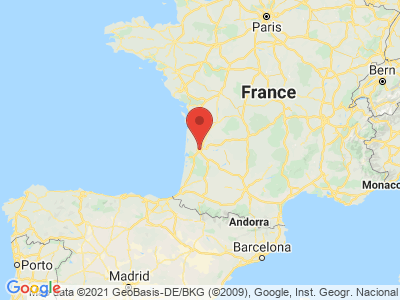Climate Table Bordeaux
Jan | Feb | Mar | Apr | May | Jun | Jul | Aug | Sep | Oct | Nov | Dec | |
|---|---|---|---|---|---|---|---|---|---|---|---|---|
| Max. Temperature | 11° | 13° | 16° | 17° | 23° | 24° | 26° | 28° | 24° | 19° | 13° | 11° |
| Min. Temperature | 4° | 4° | 6° | 8° | 13° | 14° | 16° | 16° | 13° | 10° | 5° | 4° |
| Sun Hours | 4 | 4 | 6 | 6 | 7 | 7 | 8 | 8 | 6 | 4 | 3 | 2 |
| Rain Days | 16 | 11 | 7 | 9 | 9 | 8 | 6 | 4 | 9 | 14 | 13 | 13 |
The climate year of Bordeaux
The wine-growing region of Bordeaux is the largest cohesive wine-growing region in the world and counts about 3000 wineries. The location of the wine is always designated with the associated Chateaux, individual location designations as in Germany do not exist. Approximately 6 million hectoliters of quality wine are produced each year, of which about 80% are red wines and 20% white wines. In the Médoc, the red wines are dry and fruity and in Saint-Émilion and Pomerol they are rather soft and full-bodied. The top dry white wines, full of character, thrive in the Graves area, and the noble sweet ones in Sauternes and Bersac. The huge limestone base from the Tertiary period and the glacial deposits of sand and gravel, with good drainage for water and deep rooting possibility, together with the mild climate, form excellent conditions for an exclusive wine.
General information about Bordeaux
In Bordeaux there is no lack of sights and offers to visit them. For example, a boat trip on the Garonne, past the imposing facades in the Saint-Pierre district or a stroll through the Jardin Public shows the relaxed flair of the city. The 35-meter-high Porte Cailhau, built in 1494, was part of the city walls, and inside the tourist will find an exhibition of old tools. The Porte offers a magnificent view of the Pont de Pierre, the oldest bridge in Bordeaux. A very special highlight is the "Miroir d'Eau" (water level) and is one of the most popular photo motifs in the city. Opposite the Place de la Bourse is a granite slab of 3,450 square meters that is regularly covered with about 2 cm of water and is a wonderful playground for children and a welcome cooling in the summer.
Tourism Bordeaux
With about 2,000 hours of sunshine a year, Bordeaux has more sun than most French regions. Frost-free winters, a humid spring and sun from July to October are characteristic of the city. With 900 mm of precipitation per year, these are high amounts for France, falling mainly in the winter months, with thunderstorms in the summer. The annual average temperature is 13°C, the maximum is about 20°C in July and August, the average minimum is about 6°C in January. The microclimates, so valuable for viticulture, are favored by pine forests that protect from the sea winds and the Gironde gives its balancing effect to the surrounding countryside and also reflects the solar radiation. Rain falls throughout the year, with the fewest rainy days in July/August and the most sunny hours per day in June-August. Although a balanced climate prevails in Bordeaux, heat waves can occur during extreme weather conditions, such as in 2003, when the area had 35°C - 41°C for twelve consecutive days.


